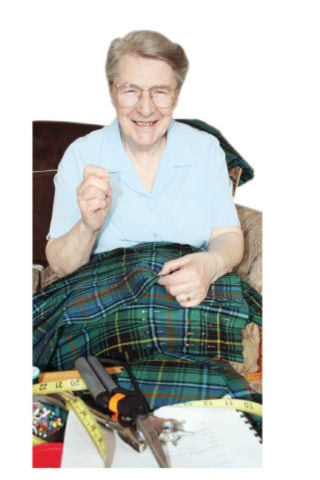Nothing is more satisfying for 70-year-old Sadie Livingston than to have a needle and thread in her hand and eight yards of tartan fabric on her lap.
The Gateway area woman is a longtime professional kilt-maker and eight yards is the length of material it takes to make one average kilt.
She’s been hand-sewing the traditional Scottish garments since about the age of five, having learned the art from her mother.
“She taught me as soon as I could thread a needle. These days, it might be called child labour but all of the kids did it. Back then, sewing was our entertainment.”
Sadie comes from Argyllshire, Scotland and her heritage is very evident in her heavy Scottish accent.
In 1971, she and her husband, John, came to Canada and to Vancouver Island, where for several years, they owned a shop called Scottish Design, which dealt in all things Scottish, including making kilts.
Knowledge of her talents spread steadily and she was highly sought after by Scottish pipe bands in particular.
She’s outfitted more bands than she can remember, including one from Duncan, which ordered 40 kilts.
Another of her commissions was to replicate a kilt from the First World War, which was in poor condition. After she painstakingly sewed the piece, it was displayed in the CFB Esquimalt Naval & Military Museum for some time.
Currently, kilt-makers tend to be members of the older generation and are becoming rare, but also in higher demand as society becomes more affluent. Sadie says kilts have enjoyed a revival since the 1960s, after people recovered from the bad economic effects of the Second World War.
Extra money became available to spend on such luxuries as handmade kilts, which commonly sell at around $800, she adds.
“Then the movie, Braveheart, really made kilts take off.”
At one time when it was becoming evident that skilled kilt-makers were getting scarce, she notes, the Scottish government had penitentiary prisoners learning how to make them in an effort to both teach them a skill and preserve the art.
Traditional kilt-making is a tough sell to younger people, as it’s a labour-intensive process with every stitch done by hand. It can take Sadie more than two days to complete just one, and that’s after decades of practice.
Detail has to be given to folding each pleat precisely so as to keep the tartan pattern running consistently around the entire kilt. Each stitch is placed so exactly that being off by one thread width makes a difference.
The most difficult kilt she ever made was one for an Ogilvie clan member. The tartan design was so intricate and busy that it made her head spin.
“I made only one, and never again. If any Ogilvie comes to me for a kilt, I suggest using their hunting tartan, which is a much tamer design.”
The finicky tailor demands perfection from herself but that has made it difficult to teach others her craft.
“I’m too fussy. I’ve had people come to me with great qualifications, but they didn’t impress me with their work.”
Each kilt tells a story through its tartan pattern, which is traditionally tied to a particular clan and their name.
When someone orders a kilt in the family tartan, the first order of business is to research his or her last name and find the matching pattern. There are more than 6,000 tartans registered in Scotland, with the regulating body being the Scottish Tartan Authority.
Sadie says there was a time when all families with the same last name were happy to share a common tartan, but people have begun to design and register new tartans specific to their own family.
Scottish people love their heritage and don’t mind sharing it within reason, she says.
The respected etiquette is that a person can wear any tartan they choose as long as they do nothing to disgrace the clan to which it belongs.
When Sadie and John sold their Scottish Design store in 2006 and moved to the South Cariboo, she had hoped to slow down a bit.
It so happened that Sadie had built up such a reputation as an expert kilt-maker that despite the move north, her good name followed her.
On moving day, even before the furniture had arrived in their new home, the phone started ringing and hasn’t stopped. Neither have her nimble fingers, which have turned out countless kilts since the move.
These days, the couple share their Gateway area home generously with bolts of colourful tartan fabrics and surrender the living room coffee table to an assortment of pins, needles, threads and other assorted sewing supplies.
On the day of this interview, Sadie was finishing the last of a batch of kilts she was making for the Williams Lake Pipe Band, which were to be ready in time for a Robbie Burns Day event in 100 Mile House. They looked sharp, using the MacInnes tartan with its shades of blue-green.
It was a big job, but even at her age, Sadie wouldn’t have life any other way.
“I wouldn’t know what to do with myself if I didn’t have a kilt to sew.”
